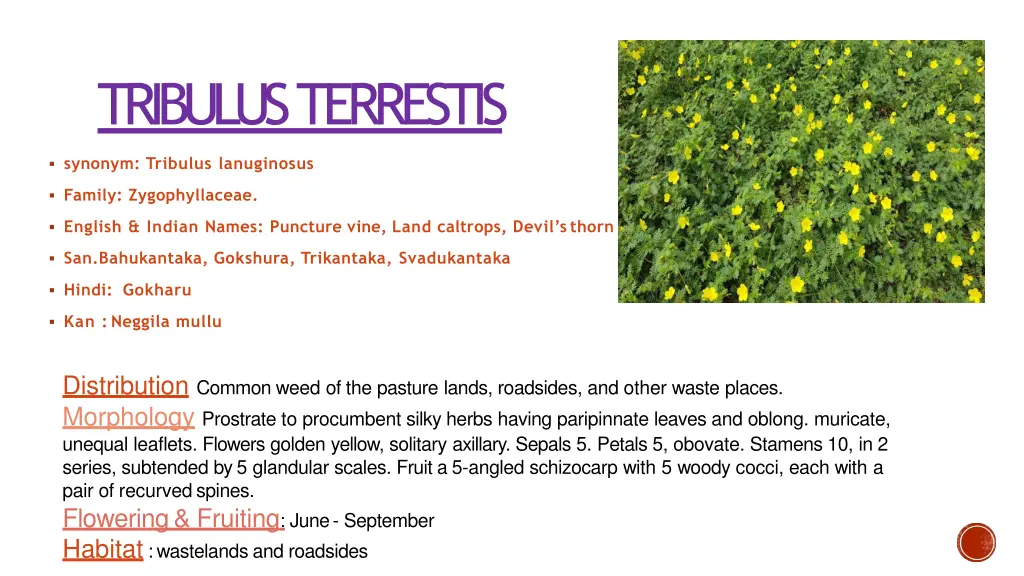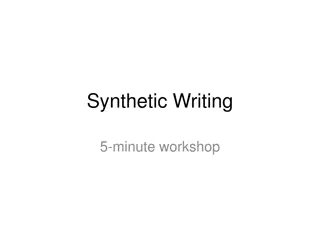
Indian Ethnobotanical Practices of Tribulus Terrestris and Pongamia Pinnata
Explore the significant Indian ethnobotanical practices associated with Tribulus Terrestris and Pongamia Pinnata, highlighting their medicinal uses, active constituents, Ayurvedic formulations, and distribution. Learn about their morphological characteristics, traditional names, and habitat preferences. Discover the diverse applications in Ayurveda and traditional medicine for various health conditions.
Download Presentation

Please find below an Image/Link to download the presentation.
The content on the website is provided AS IS for your information and personal use only. It may not be sold, licensed, or shared on other websites without obtaining consent from the author. If you encounter any issues during the download, it is possible that the publisher has removed the file from their server.
You are allowed to download the files provided on this website for personal or commercial use, subject to the condition that they are used lawfully. All files are the property of their respective owners.
The content on the website is provided AS IS for your information and personal use only. It may not be sold, licensed, or shared on other websites without obtaining consent from the author.
E N D
Presentation Transcript
TRIBULUS TERRESTIS synonym: Tribulus lanuginosus Family: Zygophyllaceae. ; English & Indian Names: Puncture vine, Land caltrops, Devil sthorn San.Bahukantaka, Gokshura, Trikantaka, Svadukantaka Hindi: Gokharu Kan : Neggila mullu Distribution Common weed of the pasture lands, roadsides, and other waste places. Morphology Prostrate to procumbent silky herbs having paripinnate leaves and oblong. muricate, unequal leaflets. Flowers golden yellow, solitary axillary. Sepals 5. Petals 5, obovate. Stamens 10, in 2 series, subtended by 5 glandular scales. Fruit a 5-angled schizocarp with 5 woody cocci, each with a pair of recurvedspines. Flowering& Fruiting: June- September Habitat :wastelands and roadsides
Significant Indian Ethnobotanical Practices Leaves: Leaf extract taken for expellingworms., Fruits: Fruit decoction given for urinary tract infection, oedema and urinary stones. Fruit ash applied for checking swelling and rheumatism. Mixture of its fruits powdered with roots of Solanum melongena consumed with milk for checking back pain and disc problems. mixture of its powdered fruits along with triphala and long pepper in proportion of 5:3:1 given with honey as a household remedy for ulcers. Fruit decoction given twice a day for expelling renal calculi and to check burning sensation during urination Seeds: seed decoction considered useful as an tonic and for checking habitual abortion. Also, its decoction with coriander seeds good against kidney and bladder stones.for checking diabetoes. Decoction of its seeds with that of Hordeum vulgare given thrice a day for checking urine blockage Mixture of its powdered seeds, coriander and rhizome of Musa paradisiaca given with milk for overcoming diseases during pregnancy.
Active Constituents :Found to contain saponins, glycosides, flavonoids, alkaloids, and tanningThe saponins ofneotigogenin, tigogenin,gitogenin,neohecogenin, hecogenin, diosgenin, ruscogenin, sarsasapogenin, and chlorogenin (plant), campesterol, stigmasterol, tigogenin, neotigogenin and -sitosterol(root). BiologicalActivity:Antimicrobialand anticancerproperties have been found to be positive. Major Ayurvedic Formulations: Goksburadi Guggul, Bonnisan, Confido, Diabecon, Geriforte, Himplasia, Renalka, Rumalaya, Rumalaya forte, Speman, Tentex Royal, Digyton. Geriforte, Dasamularista, Brhatyadikashaya, Himasagarataila, Vastyamayantakaghrta, Gokshuradi kvatha, Gokshuradi guggulu, Gokshuradi avaleha, Gokshuradi churna, Sahacaraditaila, Dasamula kvatha, Dasamulachurna, Draksadi churna, Abhayarista,
PONGAMIAPINNATA Synonyms Pongamia glabra, Derris indica Family :Fabaceae English & Indian Names:Hongay oil tree, Indian beech tree, Pongam oil tree; Sanskrit:Karanja, Karanjah, Ghratakaranja Hindi :Karanja, Dhithouri;Honge, Hongemara Distribution: Throughout tropical Asia. .Morphology : A medium-sized tree having imparipinnate elliptic, glabrous. Flowers in axillary racemes. Calyx campanulate, lobes 5. Corolla purp nate leaves. Leaflets ovate to o white; standard auricled. Stamens 10, Pods obliquely oblong, beaked. Se reniform, brown .Flowering & Fruiting:April-December Habitat: Along river banks and often planted as avenue tree.
Significant Indian Ethnobotanical Practices Bark: (i) Decoction ofbark useful againstcold, headache, acidity and infectionin lacrating mothers. (ii)Decoction of bark used as body wash for curing skin diseases and scabies (iii)Decoction of bark used for curing menstrualand digestivedisorders. iv)Paste of bark applied externally as an antidote for snakebite. (v) Infusion of bark considered useful for bleeding piles, beri-beri and diabetes. Leaves: (1) Juice of leaves given to check cold, cough, diarrhoea, dyspepsia, gonorrhoea and leprosy (ii) Medicated bath with hot infusion of its leaves considered useful for relieving rheumatic pains and forgonorrhoea. (iii) Extract of its leaves have also been found to be useful against leucoderma,leprosy. Leaves; lumbago, muscular and articularrheumatism.
Roots (1) Root paste applied for fistula and ulcers. (i) Roots used for cleaning gums andteeth Flowers 1 ) Flowers prescribedto check diabetes. Seeds :(1)Oil extracted from seeds applied for scabies, leprosy,chronic fever,ulcers, septic wounds, piles, dog bites and rheumatism. (ii)Seed paste prepared in water applied for curing skin diseases and wounds ActiveConstituents:Reported to containalkaloids demethoxy-kanugin,gamatay,g'abrin , dabrosaponin, kaempferol,kanjon,saponin, -sitosterol, and tannin (leaves) .BiologicalActivity:Inhibitory effects on Bacillus anthracis,Barillte mycoides, and Escherichili found to be positive. MajorAyurvedicFormulations:Aragvadhadhi churna,Pathyiliepa. Nagaradi cula. Varanedi kashaya,Varanadighrta,Aragvadhadi kvatha, Karanjadichurna, Karanjadighrta,

